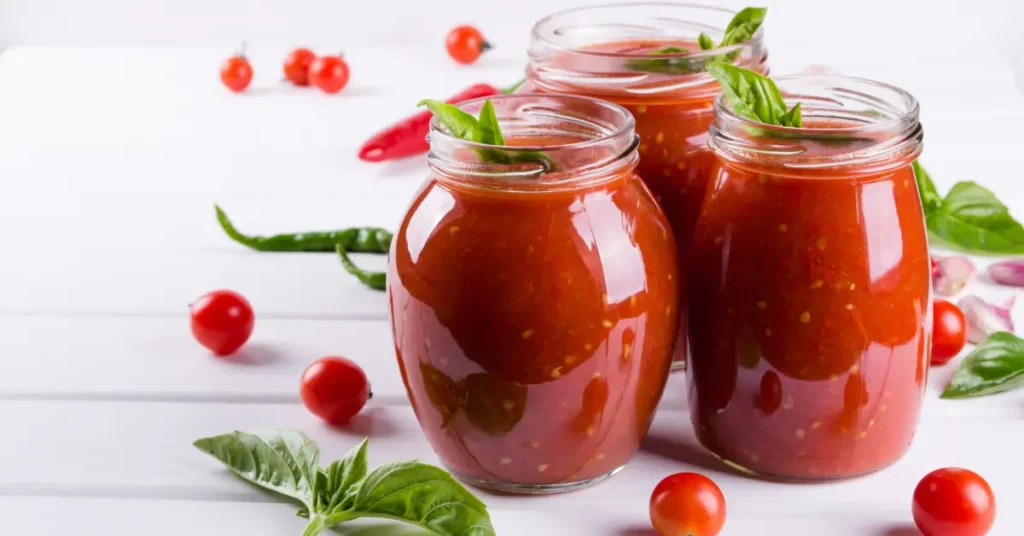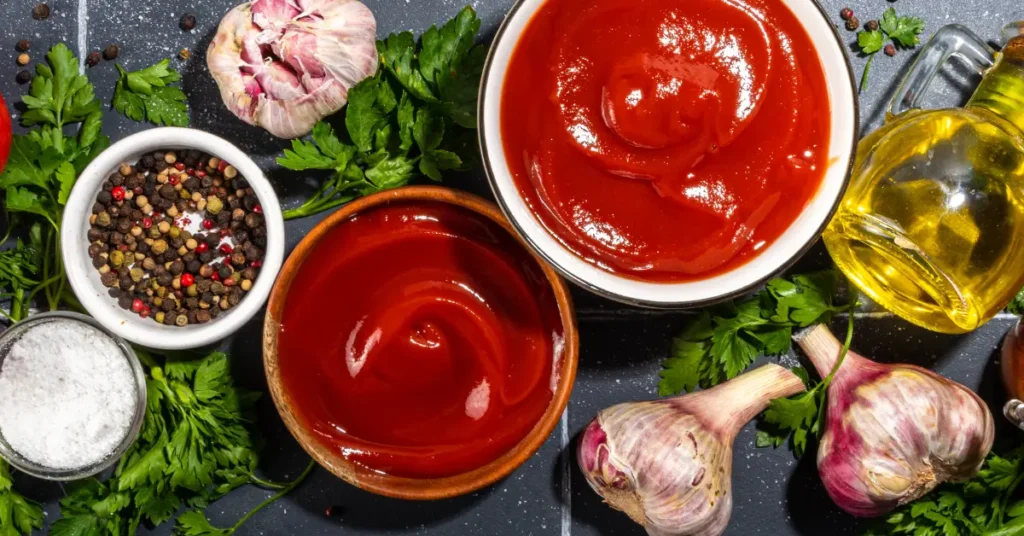
Introduction
The strange origins of ketchup start far from its current status as an American icon. This tangy staple, deeply embedded in the U.S. culinary landscape, has a story that spans continents and centuries, a journey as rich and varied as its flavors.
Peeling back the layers of ketchup’s strange origins, we uncover a global voyage. From its early days as a fish-based concoction in Asia to its transformation in Europe, the story of ketchup is as intriguing as it is diverse, reflecting a melding of cultures.
Strange Origin of Ketchup!
Ketchup, America’s favorite condiment, has a history that might surprise you. Its origins trace back to 17th-century China, where a sauce named ‘ke-tsiap’ was made from fermented fish. This original version bears little resemblance to the tomato-based ketchup we know today.
In the 1700s, British explorers encountered ke-tsiap in Southeast Asia and brought it back to Europe. The sauce underwent various transformations, with experiments including ingredients like mushrooms and walnuts. It wasn’t until the 19th century that tomatoes became the primary ingredient, leading to the ketchup we recognize now.
Table of Contents
Ketchup’s Global Ancestry – From Asian Fish Sauce to European Delicacy
Trace the fascinating journey of ketchup from its Asian origins as a fish sauce to its transformation into a European culinary staple.
Summary: This section explores the strange origins of ketchup, from its early days in Asia as a fish-based sauce to its transformation in Europe, where it adapted to local tastes and ingredients. It highlights the adaptability and evolution of ketchup as it became an integral part of different culinary traditions.
Strange origins of Ketchup Ancient Asian Beginnings
The strange origins of ketchup trace back to ancient China with kê-tsiap, a savory fish sauce. Its unique blend of spices and fish was the seed from which modern ketchup grew.
Ketchup’s journey through Southeast Asia added layers of complexity to its flavor and form, showcasing the adaptability of this sauce to various culinary traditions.
In each region, ketchup absorbed local ingredients and tastes, illustrating a remarkable journey of culinary evolution, far from its simplistic beginnings.
Strange origins of Ketchup – European Transformation
Ketchup’s introduction to Europe via British and Dutch traders marked a pivotal shift. This transition saw the beginnings of ketchup’s transformation from an Asian fish sauce to a European delicacy.
In Europe, ketchup underwent a significant transformation, adapting to include ingredients like mushrooms and walnuts, a stark contrast from its original Asian recipes.
The 17th and 18th centuries witnessed ketchup becoming a culinary mainstay in Europe, reflecting both cultural integration and gastronomic innovation.
The Tomato Revolution – Tomato Ketchup’s Rise in America
Discover how ketchup, through innovation and industrialization, became an integral part of American culinary tradition.

Summary: This section delves into the American chapter in The Strange Origins of ketchup, exploring its transition from early varied recipes to becoming a mass-produced staple. It highlights the pivotal role of industrialization and brand dynamics in shaping ketchup’s journey and status in American culture.
Strange origins of Ketchup Early American Recipes and Variations
The journey into the strange origins of ketchup uncovers its early American phase, where tomatoes first graced ketchup recipes. These initial variations, featuring locally sourced tomatoes, laid the groundwork for a culinary transformation.
Debunking the myths surrounding tomatoes, this period saw a surge in their culinary application. The acceptance of tomatoes catalyzed the birth of the modern ketchup, marking a pivotal moment in its history.
Regional variations enriched ketchup’s story in America. Each locality added its unique touch, from spices to cooking methods, contributing to the rich tapestry of ketchup’s evolution.
Strange origins of Ketchup – Industrialization and Brand Wars
Industrialization marked a significant chapter in the strange origins of ketchup, transforming it from a kitchen staple to a mass-produced phenomenon. This era saw ketchup’s production scale up, becoming accessible to a wider audience.
The rise of iconic brands like Heinz was pivotal in shaping ketchup’s identity. The Heinz revolution, characterized by its unique recipe and branding, played a crucial role in making ketchup an American household name.
The branding and advertising wars among ketchup manufacturers not only increased its popularity but also solidified its status as a cultural icon. These marketing efforts made ketchup synonymous with American dining.
Ketchup in American Culture – More Than a Condiment, A Cultural Icon
Explore how ketchup transcends its role as a mere condiment to become a symbol of American culture, influencing dining, art, and more.
Summary: In this section, we delve into how ketchup, with its strange origins, evolved into a cultural icon in American society. From its omnipresence in dining to its symbolic significance and its adaptability to health trends and future predictions, ketchup’s story is deeply intertwined with the American way of life.
Ketchup’s Cultural Significance
Ketchup’s story in American dining is a testament to its strange origins. It’s a staple from classic diners to upscale restaurants, showcasing its universal appeal across various dining experiences in the U.S.
Beyond the plate, ketchup has seeped into popular culture. It’s featured in movies, songs, and artworks, representing more than a condiment but a piece of American life.
Ketchup holds symbolic weight in American society, representing comfort, tradition, and innovation. Its journey from a simple sauce to a cultural icon reflects America’s diverse culinary story.
Modern Innovations and Health Trends
Ketchup continues to evolve with new varieties like organic, low-sugar, and artisanal options, reflecting the changing preferences and health consciousness of American consumers.
Ketchup’s role in health and nutrition discussions emphasizes its adaptability. It’s part of conversations about balanced diets, underscoring its relevance in modern dietary trends.
Looking ahead, ketchup is poised to adapt to emerging trends and tastes. Predictions suggest continued innovation, keeping ketchup relevant in the ever-changing landscape of American food culture.
Global Impact and Diverse Adaptations: Ketchup’s Worldwide Influence
Delve into how ketchup, with its unique beginnings, has left a flavorful mark globally, influencing cuisines and cultures far and wide.

Summary This section explores the strange origins of ketchup and its transformation into a globally influential condiment. From the creation of unique variations like curry and banana ketchup to its significant impact on international cuisines and cultural gastronomy, ketchup’s story is one of remarkable versatility and adaptation.
Ketchup Around the World
The strange origins of ketchup have led to its worldwide presence. Each country has embraced ketchup, adding their local twist, from spicy variants in Asia to sweeter versions in Europe.
This global journey highlights ketchup’s versatility, adapting to different palates and culinary traditions, making it a global kitchen staple.
The story of ketchup is one of culinary migration and adaptation, a testament to how a simple sauce can transcend borders and become a part of diverse cultures.
Global Variations: From European Curry Ketchup to Asian Banana Ketchup
In Europe, the strange origins of ketchup take a spicy turn with curry ketchup, a beloved variant that combines traditional ketchup with the rich flavors of curry spices.
Asia offers a unique twist with banana ketchup, a fruity and tangy variant that reflects the region’s innovative approach to traditional flavors.
These variations not only illustrate ketchup’s adaptability but also its ability to blend seamlessly into the culinary fabric of different continents.
Ketchup’s Influence on International Cuisines
Ketchup’s strange origins have paved the way for its influence in international cuisines, where it’s used as a base for sauces, marinades, and more.
This influence extends beyond mere flavor, impacting cooking techniques and food pairing principles in various cultures.
Ketchup’s versatility allows it to blend into numerous culinary styles, making it a globally recognized ingredient that enhances and transforms dishes.
Cultural Exchange: How Ketchup Adapted to Different Cultures
The strange origins of ketchup have facilitated a cultural exchange, as it has been adapted and reinvented across the globe.
This adaptation is a celebration of global gastronomy, showing how a single condiment can embody the taste preferences of diverse populations.
Ketchup’s journey from its humble beginnings to a global phenomenon is a story of culinary innovation and cultural acceptance.
Conclusion – Reflecting on Ketchup’s Culinary Odyssey
The strange origins of ketchup reveal a story of transformation like no other. From its early days as a humble Asian sauce to becoming a beloved modern condiment, ketchup’s journey is a testament to culinary adaptability and innovation.
Ketchup’s story intertwines deeply with American culture. It’s more than a condiment; it’s a symbol of American culinary ingenuity and a staple in every kitchen, reflecting the nation’s diverse palate and culinary heritage.
As we consider the ongoing evolution of ketchup, its strange origins remind us of its unique place in the world’s culinary history. Its journey continues, mirroring changes in tastes, cultures, and culinary techniques globally.
“You May Also Interest This, Please Read”
Why Does Popcorn Pop?
Frequently Asked Questions – FAQs
Ketchup wasn’t always tomato? What was it made of then?
Nope, not at all! Ketchup started its journey as a fermented fish sauce in China centuries ago. Imagine salty anchovies and soybeans instead of sweet tomatoes!
But how did it go from fishy to fruity?
British sailors brought the sauce back from Asia, and over time, ingredients like mushrooms, walnuts, and even oysters made their way in. Tomatoes finally joined the party in the 1800s, though they were thought to be poisonous at first!
Fish and tomatoes are weird, but what about ketchup and… ketchup? Did it always look like the red stuff we know?
Nope again! Early ketchups were brown, thin, and sometimes even spicy. The iconic red color and thick texture we love today came much later, thanks to companies like Heinz.
So, ketchup used to be like a funky condiment buffet?
Exactly! People experimented with all sorts of things, from fruits and spices to pickles and even beer. It was a wild flavor ride!
I guess I’m glad it settled on tomatoes then. But were there any other crazy ingredients that almost made the cut?
Believe it or not, some recipes called for clams, oysters, and even eels! Thankfully, those didn’t stick around.
Is there any ketchup out there that still remembers its fishy past?
Actually, yes! Some Southeast Asian ketchups are still made with fermented fish or shrimp, carrying on the original tradition.
Ketchup’s story is weirder than I thought. Did anyone actually like it back then?
Oh yeah! Ketchup was considered a luxury item at first, enjoyed by wealthy folks and even royalty. It was seen as exotic and flavorful, a real taste of adventure!
I bet it wasn’t exactly dippable with all those crazy ingredients, right?
ou’re right! Early ketchups were more like sauces or marinades, drizzled on meat or used to flavor stews. Fries and burgers would have been very confused!
This is kind of blowing my mind. Any other condiments with equally strange beginnings?
Oh for sure! Mustard started as a spicy paste used in medicine, and Worcestershire sauce was originally a fishy, fermented brew. Food history is full of surprises!
